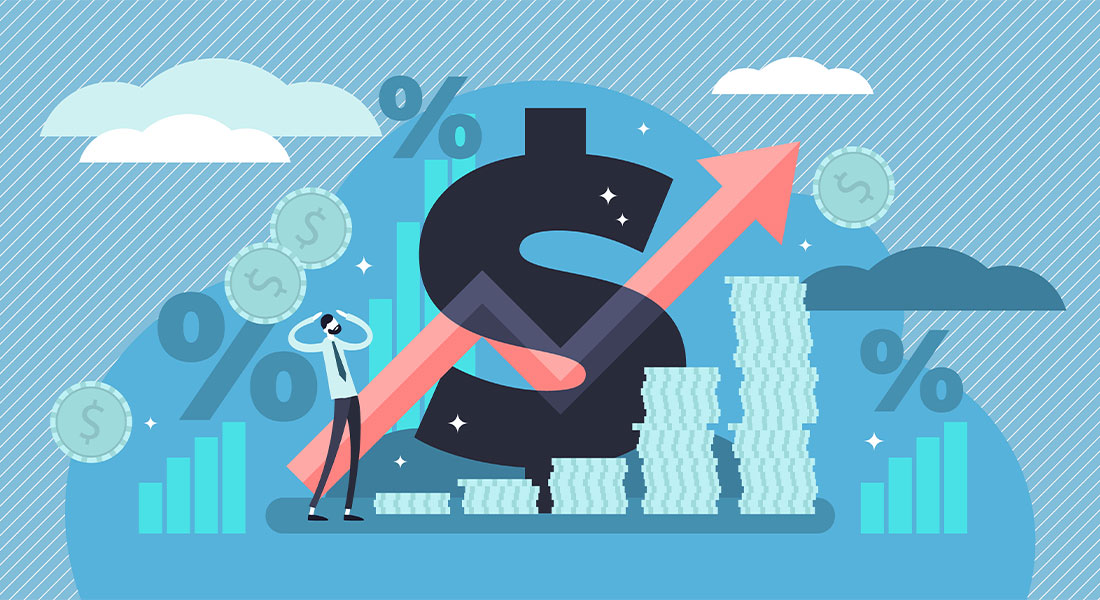 Contact
About Us
Articles
Home
Contact
About Us
Articles
Home

Most people don’t pay much attention to inflation until it hits their wallets. And even then, they usually only comment on how the price of gas and food is really starting to pinch.
But government officials, bankers and the talking heads on cable TV have been watching inflation carefully – ever since the Consumer Price Index (CPI) broke above its healthy target of 2% per year. Then, for the 12 months ending in January 2022, the CPI exploded to 7.5%. Inflation hadn’t reached that point since the early 1980s, yet some still remember how it disrupted the economy. (For perspective, at the annual inflation rate of 7.5%, your cash savings could be cut in half in less than 10 years.)
The Federal Reserve is the central bank of the United States. Among other things, it is responsible for “promoting maximum employment, stable prices and moderate long-term interest rates in the U.S. economy.”
When asked, its leaders repeatedly declared that the economy’s higher inflation numbers were only “transitory,” caused by pandemic issues that were resolving. Some still believe that. But others think the economy has more fundamental problems that could make increasingly higher prices a part of the scenario for years to come.
So, what is inflation exactly? The Bureau of Labor Statistics (BLS) says it’s “the overall general upward price movement of goods and services in an economy.” It chips away at the value of your money. As prices go up, each dollar is worth less.
Whenever something out of the ordinary happens – such as the exceptional inflation rate of 7.5% in January 2022 – we tend to go back to the last time something similar happened, hoping to find guidelines or orientation for how to proceed.
But 2022 has nothing in common with 1982: The country is coming back from a devastating pandemic that disrupted every aspect of our lives, as well as the global economy. And 40 years of technological advances have changed how virtually everything works.
So, while looking at historical precedent is never wrong, we do have to look at it in the context of this unique time.
What we can’t do is look at inflation only as the high cost of a gallon of gas or groceries. Instead, to make sound financial decisions in the short term – and for our retirement – we need to look at all the other ways inflation can affect our financial lives.
Modest inflation levels of 1% to 3% are said to be healthy for the economy. But inflation starts impacting your cost of living when it’s more than a few price hikes, and it begins to raise the cost of housing, energy, health care and all your other non-discretionary expenses. You will feel the increases more if you are on a fixed income or lack the power to renegotiate your salary to keep up with rising costs.
Once buying essentials consumes most of your income, you may have to give up some of the discretionary expenses that improve your quality of life. You might be able to tap into savings to cover them for a while or adjust your investments to generate higher returns. Or you might change some of your behaviors to lessen the impact. But if none of these are possible, you might have to consider lowering your living standard.
The longer high inflation persists, the greater the number of population segments are affected.
Whether you are aware of it or not, if your paycheck didn’t increase by last year’s inflation rate or more, your paycheck was cut in 2021.
So, what about 2022?
The pandemic affected the standard patterns of salary increases, primarily because of business shutdowns and labor shortages that led employers to pay hiring bonuses and premiums on top of wages. However, those patterns are expected to stabilize in 2022.
And the Conference Board confirms this. It conducted a survey in April and May of 2021 in which the median total U.S. salary-increase budgets rose 3% that year, which matched the increases during the decade before that. And 2022 is expected to be about the same for employees of all categories: executive, exempt, non-exempt hourly and salaried.
However, the January 2022 inflation report of 7.5% year-over-year indicates that such raises will be outpaced by inflation.
If you have the power to negotiate your salary, you might be kept whole. If not, your best chance seems to be to change jobs. An ADP report indicates that job switchers had the healthiest wage growth, probably because employers in several sectors are struggling to find workers willing to work. For example, in early 2021, job switchers grew their wages by 4.7%, and by the fourth quarter of 2021, averaged 7.5% – equal to the CPI reported for January 2022.
Different inflation rates can cause different ripple effects in the economy, eventually affecting employment levels. However, the disruptions caused by the pandemic have overshadowed what might otherwise be happening in the economy.
The multiple rounds of pandemic-related stimulus payments, including the monthly child tax credits, put too much money in consumers’ hands. At the same time, lockdowns and social distancing reduced spending on travel and personal experiences, and the focus shifted to buying products.
The result is strong consumer demand when supply chains are disrupted and not enough workers are willing to work at production and distribution, thus leading to product shortages. (In fact, it is said that there are 1 million more jobs in early 2022 to be filled than people looking for work.)
However, suppose high inflation persists long enough. In that case, it could absorb the excess money in the economy, raise prices so products are less affordable, and eventually affect the willingness of businesses to invest in their companies and hire employees.
Workers whose salaries keep up with inflation are not hurt by it; they’ll either break even or do better. But those who live on a fixed income are. And that includes the 70 million Americans who receive Social Security benefits.
The Social Security Administration does provide a cost-of-living adjustment (COLA) almost every year, but that increase does not keep up with inflation. As a result, beneficiaries know that the increase they receive through COLA will be less than how much more they pay for essentials. They also know that they will have to pay a higher premium for Medicare Part B each year, which is usually deducted from their Social Security checks.

Even Social Security recipients who have other resources will notice their checks contributing less and less over the years. But beneficiaries who receive average (or smaller) benefit checks are harmed the most. Here’s how it works:
Social Security calculates the COLA on the Consumer Price Index for Urban Wage Earners and Clerical Workers (CPI-W). But unfortunately, this is a “lagging indicator” that measures how much was lost in the prior year. So the face value of a beneficiary’s check may be corrected once a year, but only after it lost purchasing power for the last 12 months. And it will fall behind for another year before it gets corrected again. In short, COLA never quite makes beneficiaries whole.
And how does the Medicare Part B premium affect them? Let’s look at some numbers.
COLA for 2021 was 1.3% which, on the average Social Security check, meant a $20 increase. The 5.9% COLA for 2022 was heralded as an extraordinary improvement, and it resulted in $92 extra for the average check.
But, in 2021, the monthly Medicare Part B premium rose by $9.10, and in 2022, by $21.60. Subtracting the premium increase wiped out 46% and 23% of the COLA increases, respectively.
Since COLA is a percentage, beneficiaries with larger checks receive somewhat larger COLA increases in dollars. However, the ones who need the most help will have to make do with a net gain of $11 or $70 per month to cover the increased cost of home heating or prescription drugs. Remember, the 2022 COLA was 5.9%, and the January year-over-year CPI was 7.5%.
So, yes, inflation can hurt those receiving government benefits.
Fixed-rate debt holders benefit from inflation. If inflation causes the dollar to lose value, the dollars you use to pay off your debt are worth less than those you originally borrowed.
This is the case for all debt forms that do not adjust for inflation. If you have any plans to take out a fixed-interest loan, say to refinance your home or finance an income-producing property, this is the time to do so, as inflation is on its way up.
The benefit of fixed-rate loans is seen best with homeowners who pay off their mortgages over 30 years. For example, 30-year-fixed mortgage rates have been increasing from historic lows. But, at Christmas 2021, their rate was 3.2%, and two months later, it was nearing 4%. And it is expected to keep climbing as efforts are made to rein in inflation by raising the cost of money.
Yet, as long as the interest rate is fixed, you will pay the same dollar amount for up to 30 years, and it will represent less and less of your income. Meanwhile, the bank (the loan holder) will make less and less on its investment.
Adjustable-rate debt is less attractive in times of inflation. An example is an adjustable-rate mortgage or ARM. You may start with a preferential interest rate for a fixed period (say one, five or 10 years). Then your payments are allowed to follow an agreed-upon formula tied to an index which allows the interest rate to increase with inflation. The risk is that you might have to pay a higher monthly bill when your income has not kept up with inflation, which could put you under financial pressure.
Borrowers may benefit from inflation, but savers do not, especially if they keep their money in cash. So finding a place to hold your money safely where interest rates are high enough to protect it from inflation-based loss is a challenge.
Because of the low returns on cash, some advisors suggest keeping most of your retirement savings invested where your money can grow faster than inflation can diminish its value. An exception is if you are too close to retirement to recuperate from surprise losses.
In that case, near-term retirement savings and emergency funds should be held in low-risk applications such as certificates of deposit (CDs), money market accounts or one of the more aggressive, higher-yield online banks. Of course, you still may not keep up with inflation.
On the other hand, one popular strategy savers are flocking to is a fixed index annuity. These hybrid-type alternatives allow market-like returns while also providing safety, like a CD. They provide a kind of insurance for your money when things are bad, and also allow you to participate in some market-like gains. This allows you to keep a closer pace with inflation and enjoy the safety you are looking for.
Other savings, such as the down payment on a house or college tuition, can also be hurt by inflation. You can lose the purchasing power of the money saved if you are not receiving interest rates greater than inflation.
In recent years, housing prices have been rising extraordinarily. Inflation has played a role in the process, but so has the lack of inventory to sell. During the pandemic, construction delays meant fewer houses were built. And many sellers held off through the peak of the pandemic and entered the market simultaneously.
Market pressures are favorable for you as a seller, as they bring you higher prices quickly. But they’re not helpful on the flip side of the transaction: as a buyer of a replacement property. However, if it is true that housing prices may be reaching a peak, this might be a good time to sell. And if you are not in a rush to buy, even better.
Inflation could play a role in lowering the market pressures. As the federal government raises the federal funds rate to manage inflation, banks will have to pay more for the money they borrow in order to lend. And, as mortgage rates rise, fewer people will be looking to buy.
Inflation can also affect you if you are simply planning to stay in your existing home. As you plan for your costs in retirement, inflation can ruin your budget by pushing up the amount you have to pay in ongoing expenses such as property taxes or required home repairs.
Investments come in two forms: debt and equity. We looked earlier at both sides of debt – as a borrower and a lender. We decided that being a borrower with fixed interest rates can be advantageous in inflationary times, but being a lender is likely not.
Owning fixed-income assets such as bonds and Treasury notes pays out the same dollar amount each year. The safety of such instruments is appealing, particularly if they are Treasury notes guaranteed by the U.S. government. However, if the return on an asset is lower than the inflation rate, you will be losing value with time.
Equities make much more sense. For one, inflation does not necessarily mean returns will be below average or negative. And you have the option of selecting sectors known historically to hold up well in inflationary environments. Equities may go up or down in the short term, but they provide the best chance of a real return in the long term that beats inflation.
There have been several studies conducted on a new alternative to bond investments. This alternative has been shown to produce market-like returns while still offering the same principal protection. They are also known for providing a stream of protected lifetime income. That is, an annual stream of income that you cannot outlive. Various income options are available including inflation protected income payments.
Inflation is always part of the calculation whenever retirement plans are being developed. Not only is it an integral part of investment strategies during the pre-retirement phase, but it is also critical as you determine how resources will be spent over the 20 or 30 years of retirement.
Knowing what figure to use for inflation – and when – becomes the challenge. The Federal Reserve targets 2% inflation, which would have been a good guess these past few years. But the recent jump to 7.5% for January 2022 – if not factored in somehow – could do considerable damage over the long term. The goal is to fund your desired lifestyle and not compromise because of faulty assumptions.
That makes consideration of inflation a critical issue.
As stated, inflation always creates winners and losers. As an investor, fixed-rate debtor and sought-after wage earner, you can be a winner. As a saver, fixed-rate creditor and fixed-income earner, you can easily be a loser. But inflation goes beyond them to affect other aspects of your retirement plan. What about your pensions? How do they respond to inflation? And your insurances, such as for long-term care? Are benefits all fixed, or do they include inflation riders?
A well-designed retirement plan is complex, even before considering inflation. But the January 2022 CPI report of 7.5% year-over-year has been a powerful wakeup call that we are not beyond being affected by persistent, destructive inflation. So if ever there was a reason to ask an Alliance America financial professional for advice, this might be it.
Alliance America is an insurance and financial services company dedicated to the art of personal financial planning. Our financial professionals can assist you in maximizing your retirement resources and achieving your future goals. We have access to an array of products and services, all focused on helping you enjoy the retirement lifestyle you want and deserve. You can request a no-cost, no-obligation consultation by calling (833) 219-6884 today.


